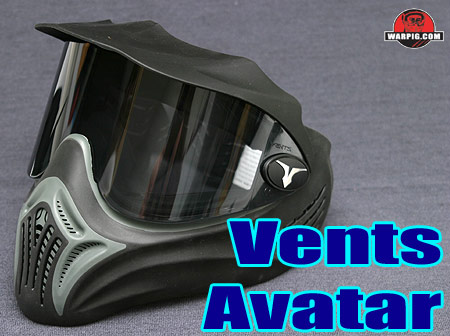
Vents Avatar
By Bill Mills - Nov 2005
In the 1980s players did not have anywhere
close to the number of options they have today in terms of goggle systems.
In fact it was not until the late 1980s that goggle systems were even produced
specifically for paintball – a serious problem at the time, as the often-used
workshop goggles did not provide adequate face and eye protection.
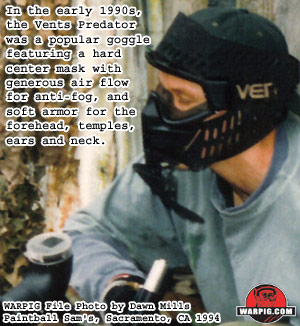 By
the late 1980s players had two primary choices of paintball goggle lines
– JT and Scott, until a new player stepped into the game – Vents.
In the early 1990s the Vents Predator goggle system provided traditional
goggle coverage for the eyes with hard protection over the center of the
face, and soft protection for the neck and sides of the face. Its
primary marketing focus centered around the goggle system’s airflow design
which minimized fogging by separating the vents for hot humid breathing
air from the vents that allowed air flow to the space between the goggle
lens and eyes. By
the late 1980s players had two primary choices of paintball goggle lines
– JT and Scott, until a new player stepped into the game – Vents.
In the early 1990s the Vents Predator goggle system provided traditional
goggle coverage for the eyes with hard protection over the center of the
face, and soft protection for the neck and sides of the face. Its
primary marketing focus centered around the goggle system’s airflow design
which minimized fogging by separating the vents for hot humid breathing
air from the vents that allowed air flow to the space between the goggle
lens and eyes.
While the Vents Predator was popular
and well received, its manufacturer eventually went out of business competing
with Scott and JT. The Vents product line was purchased by Scott,
which sold remaining stock of replacement parts, and eventually dropped
the line.
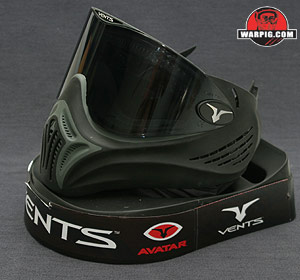 In
2005, the name Vents has reappeared, but this time it is on an all new
goggle – and not just one goggle, but a complete goggle line from low end
to high end. National Paintball Supply had acquired the rights to
the Vents name, and Simon “Manike” Stevens, the company’s director of research
and development was tasked with designing the new goggles. While
the new Vents look very little like their predecessors, they do share a
similar design concept – separated air flow to combat fogging. In
2005, the name Vents has reappeared, but this time it is on an all new
goggle – and not just one goggle, but a complete goggle line from low end
to high end. National Paintball Supply had acquired the rights to
the Vents name, and Simon “Manike” Stevens, the company’s director of research
and development was tasked with designing the new goggles. While
the new Vents look very little like their predecessors, they do share a
similar design concept – separated air flow to combat fogging.
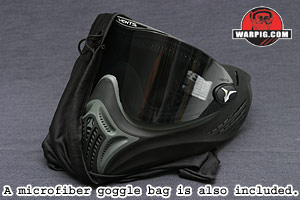 The
new Vents line begins with the Vents Helix, and moves on up through the
Vents Cylus, Vents Avatar, and the E-Vent which is sold under the Empire
brand name. An unusual feature to the product line is that all of
the models use interchangeable parts providing an upgrade path. This
means that a player can start off with the Helix, and change parts until
they end up with the high end E-Vents model, while all the spare lenses,
visors and straps can still be used. The
new Vents line begins with the Vents Helix, and moves on up through the
Vents Cylus, Vents Avatar, and the E-Vent which is sold under the Empire
brand name. An unusual feature to the product line is that all of
the models use interchangeable parts providing an upgrade path. This
means that a player can start off with the Helix, and change parts until
they end up with the high end E-Vents model, while all the spare lenses,
visors and straps can still be used.
The models field tested in this review
were both Vents Avatars, part of a pre-production run released in limited
numbers at the 2005 Paintball World Cup and Commander’s Cup. Minor
changes have been planned before the full production release in time for
Christmas. These changes are expected to be so insignificant that
the pre-production models well represent the final product.
 When
unpacking the Vents goggles, the first impression comes not from the goggle
itself, but from the box. Rather than cardboard, the Vents are packaged
in a two-part injection molded case. A base holds the goggles and
accessories, while the clear top section protects the contents. The
two halves are joined by a wraparound adhesive label. The top of
the Vents case is one of the components scheduled to change between the
release and pre-release versions. In the pre-release versions, the
upper half of the case is mostly clear, with a milky white quality – it
is planned to be clearer in the final production models. When
unpacking the Vents goggles, the first impression comes not from the goggle
itself, but from the box. Rather than cardboard, the Vents are packaged
in a two-part injection molded case. A base holds the goggles and
accessories, while the clear top section protects the contents. The
two halves are joined by a wraparound adhesive label. The top of
the Vents case is one of the components scheduled to change between the
release and pre-release versions. In the pre-release versions, the
upper half of the case is mostly clear, with a milky white quality – it
is planned to be clearer in the final production models.
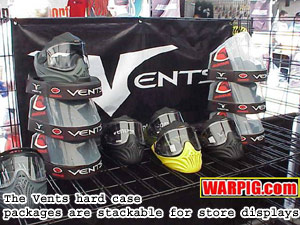 While
the case has an unusual shape, it allows the goggle inside to be seen,
and is stackable, to several units high, making it easy for dealers to
handle on their shelves. In addition to initial shipping it can also
be used later as a protective case, keeping the goggles from getting smashed
in a gear bag. The base section can be cut down with a knife to reduce
its size and hinged to the top with duct tape for long term travel use. While
the case has an unusual shape, it allows the goggle inside to be seen,
and is stackable, to several units high, making it easy for dealers to
handle on their shelves. In addition to initial shipping it can also
be used later as a protective case, keeping the goggles from getting smashed
in a gear bag. The base section can be cut down with a knife to reduce
its size and hinged to the top with duct tape for long term travel use.
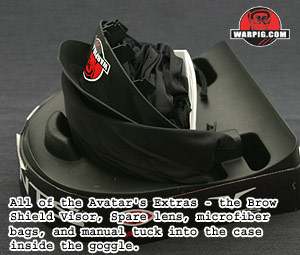 Inside
the case one finds the goggle and its components. Included with the
Avatar are the goggle itself with a smoke tinted lens, a microfiber carrying/cleaning
bag for the goggle, a spare clear lens, a microfiber carrying/cleaning
bag for the spare (all replacement lenses also include such a bag) and
both a brow shield and a visor. Lower end models do not include the
visor – for them it is an upgrade. The Cylus ships with only the
brow shield, and the Helix with a “browser” – a combination visor and brow
shield. The second lens included with the Avatar is also an option
not bundled in with the lower level models. Inside
the case one finds the goggle and its components. Included with the
Avatar are the goggle itself with a smoke tinted lens, a microfiber carrying/cleaning
bag for the goggle, a spare clear lens, a microfiber carrying/cleaning
bag for the spare (all replacement lenses also include such a bag) and
both a brow shield and a visor. Lower end models do not include the
visor – for them it is an upgrade. The Cylus ships with only the
brow shield, and the Helix with a “browser” – a combination visor and brow
shield. The second lens included with the Avatar is also an option
not bundled in with the lower level models.
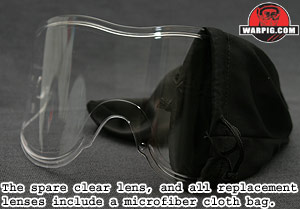 A
look at the goggle starts with the lens. The new Vents lenses are
molded from polycarbonate with anti-fog coated surfaces.
The lens is of a roughly cylindrical design – that is it curves from right
to left, but not vertically like a “bubble” lens. A
look at the goggle starts with the lens. The new Vents lenses are
molded from polycarbonate with anti-fog coated surfaces.
The lens is of a roughly cylindrical design – that is it curves from right
to left, but not vertically like a “bubble” lens.
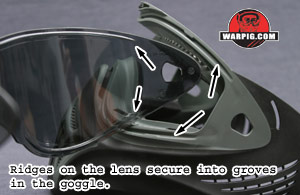 Ridges
on the back-side of the lens, along the top and bottom fit into grooves
in the mask. These ridges serve dual purposes. First they retain
the lens, preventing it from being able to shift up or down. Secondly,
they act as a barrier, so that splattered paint on the mask cannot blow
through the gap between the lens and the goggle frame. Tiny air gaps
both before and after the ridge are designed to prevent capillary action
from drawing splattered paint up under the lens as well. At the nose
bridge, the center of the lens actually snaps under the mask, giving it
extra strength to protect against an impact in that area. Ridges
on the back-side of the lens, along the top and bottom fit into grooves
in the mask. These ridges serve dual purposes. First they retain
the lens, preventing it from being able to shift up or down. Secondly,
they act as a barrier, so that splattered paint on the mask cannot blow
through the gap between the lens and the goggle frame. Tiny air gaps
both before and after the ridge are designed to prevent capillary action
from drawing splattered paint up under the lens as well. At the nose
bridge, the center of the lens actually snaps under the mask, giving it
extra strength to protect against an impact in that area.
On either side end of the lens are its
certification and date stamps. A CE logo shows that the lens is designed
compliant with European eye protection standards. On the opposite
side, the Protective Eyewear Council logo means that the manufacturer has
informed the Protective Eyewear Council that a third party A2LA compliant
laboratory has tested the lens design and shown it to meet the applicable
standards – in this case ASTM F1776-99a. Also, as required by ASTM
F1776-99a, a small calendar wheel indicates the year and month the lens
was manufactured.
 The
lens varies in thickness, as a part of its design, in order to present
a more optically correct image, without distortion or astigmatism.
In addition to the anti-fog coating found on the stock single pane lenses,
National also offers a more traditional thermal dual pane lens. With
the thermal model an inner lens is separated from the outer lens by a thin
airspace. This airspace acts as an insulator to allow the inner lens
to remain at the warm temperature of the humid air near the face, while
the outer lens cools to the outside temperature, inhibiting condensation
and fog. The
lens varies in thickness, as a part of its design, in order to present
a more optically correct image, without distortion or astigmatism.
In addition to the anti-fog coating found on the stock single pane lenses,
National also offers a more traditional thermal dual pane lens. With
the thermal model an inner lens is separated from the outer lens by a thin
airspace. This airspace acts as an insulator to allow the inner lens
to remain at the warm temperature of the humid air near the face, while
the outer lens cools to the outside temperature, inhibiting condensation
and fog.
A hole on either side of the lens allows
it to be held into the mask by its retention system. A pair of hard
molded lens retainers go through the hole in the lens and through a similarly
shaped hole in the goggle. Inside the goggle they are twist locked
into retainers on each end of the goggle strap. Not only is this
system easy to remove quickly, but it holds the lens very solidly in place.
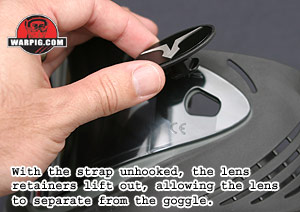 The
lens retainers are oval shaped on the outside and feature small machined
aluminum vanity plates with the Vents or Empire (in the case of the E-Vents)
logos. Because the metal inserts are CNC machined rather than injection
molded, it is relatively simple for National Paintball Supply or after
market machine shops to produce custom vanity inserts with team or other
brand logos. Changing out the vanity plate does not affect the strength
of the lens retainer, as it is little more than a metal sticker on the
surface of the retainer. The
lens retainers are oval shaped on the outside and feature small machined
aluminum vanity plates with the Vents or Empire (in the case of the E-Vents)
logos. Because the metal inserts are CNC machined rather than injection
molded, it is relatively simple for National Paintball Supply or after
market machine shops to produce custom vanity inserts with team or other
brand logos. Changing out the vanity plate does not affect the strength
of the lens retainer, as it is little more than a metal sticker on the
surface of the retainer.
Directly behind the lens is the Vents
goggle itself. The Avatar goggle is manufactured in a dual-shot injection
molded process. First the rigid underframe is injection molded, then
half of the mold is swapped out, and the more flexible regions of the mask
are injected while the first material is still hot, allowing the two to
bond together solidly. Sleek lines and vent slots define the shape
of the Avatar mask in a look that is very un-like the old-school Vents
Predator of the 1990s.
Like most modern paintball goggle systems,
the new Vents goggle frame is integrated into the mask, a feature which
discourages less intelligent players from removing the mask – something
that not only removes protection from the face, but from the eyes as well,
as the mask protects the goggle from paint bouncing underneath its edges
and into the eye.
Dual density foam around the goggle
area provides a secure and snug fit to the face.
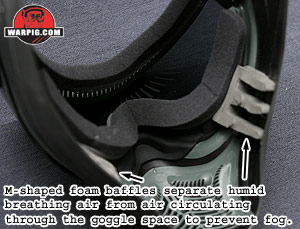 Unlike
most paintball masks, the Vents do not feature air paths from the mouth
and nose area directly to the airspace behind the lens. As with the
original Vents goggles, this is to prevent warm, moist exhaled air from
entering that space and fogging the goggle. A pair of M shaped foam
inserts over the cheeks act as baffles, minimizing the amount of air moving
in the center of the mask that can get to the eye space from the sides. Unlike
most paintball masks, the Vents do not feature air paths from the mouth
and nose area directly to the airspace behind the lens. As with the
original Vents goggles, this is to prevent warm, moist exhaled air from
entering that space and fogging the goggle. A pair of M shaped foam
inserts over the cheeks act as baffles, minimizing the amount of air moving
in the center of the mask that can get to the eye space from the sides.
 Because
of the double-shot molding the Avatar mask is rigid in the front, protecting
the nose and mouth from paintball impacts. As one progresses along
the cheeks toward the ear areas, the mask becomes more flexible increasing
the chance of a bounce while still protecting from the harsh sting of a
direct skin impact. The Avatar provides protection from the jaw to
the forehead, and back behind the ears on the sides. The amount of
forehead and temple protection provided depends on whether the optional
visor or brow shield is used. Because
of the double-shot molding the Avatar mask is rigid in the front, protecting
the nose and mouth from paintball impacts. As one progresses along
the cheeks toward the ear areas, the mask becomes more flexible increasing
the chance of a bounce while still protecting from the harsh sting of a
direct skin impact. The Avatar provides protection from the jaw to
the forehead, and back behind the ears on the sides. The amount of
forehead and temple protection provided depends on whether the optional
visor or brow shield is used.
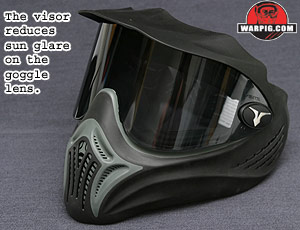 The
visor, brow shield, or optional browser attaches to the top of the goggle
air slots in the top of the frame. These components use a simple
push through tab connection. All three of these components are molded
of semi-rigid material. The
visor, brow shield, or optional browser attaches to the top of the goggle
air slots in the top of the frame. These components use a simple
push through tab connection. All three of these components are molded
of semi-rigid material.
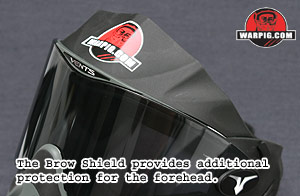 The
browser is a standard feature with the Vents Helix. As the Helix
is designed as an entry level or field rental model, the browser provides
some extra protection to the forehead when compared to the visor, and also
helps the lens last longer, as it prevents the outer lens surface from
contacting the ground if the goggle is set face down by a careless renter. The
browser is a standard feature with the Vents Helix. As the Helix
is designed as an entry level or field rental model, the browser provides
some extra protection to the forehead when compared to the visor, and also
helps the lens last longer, as it prevents the outer lens surface from
contacting the ground if the goggle is set face down by a careless renter.
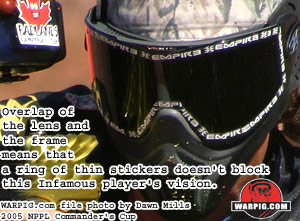 Along
the top of the goggle at the center is another glued in vanity plate with
the Vents logo. This too can be replaced with a custom plate.
Because of the ridge and channel system which lines the top and bottom
of the lens, there is a dead space of approximately ¼ inch along
the top and bottom of the goggle lens where there is a smooth flat lens
surface, but the wearer can not see through. Already at the initial
launching of the new Vents, some Empire sponsored teams were making use
of this for narrow strips of sponsor stickers, a location that is sure
to show up in close up magazine shots, but will have no affect on the player’s
field of vision. Along
the top of the goggle at the center is another glued in vanity plate with
the Vents logo. This too can be replaced with a custom plate.
Because of the ridge and channel system which lines the top and bottom
of the lens, there is a dead space of approximately ¼ inch along
the top and bottom of the goggle lens where there is a smooth flat lens
surface, but the wearer can not see through. Already at the initial
launching of the new Vents, some Empire sponsored teams were making use
of this for narrow strips of sponsor stickers, a location that is sure
to show up in close up magazine shots, but will have no affect on the player’s
field of vision.
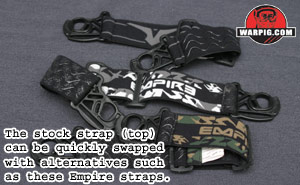 Wrapping
up the goggle system in the back is the strap. Like many goggle straps
in paintball the Vents strap features dual cinch buckles for easy adjustability.
Pulling out on the straps expands them, while pulling out on the buckles
tightens. A triple bead of silicone on the inside of the strap gives
it additional friction to prevent slippage. On either end of the
strap are the strap retainers, which lock into the goggle’s lens retainers.
The system is most unique compared to most paintball goggles where changing
the strap is a fairly complex task. Wrapping
up the goggle system in the back is the strap. Like many goggle straps
in paintball the Vents strap features dual cinch buckles for easy adjustability.
Pulling out on the straps expands them, while pulling out on the buckles
tightens. A triple bead of silicone on the inside of the strap gives
it additional friction to prevent slippage. On either end of the
strap are the strap retainers, which lock into the goggle’s lens retainers.
The system is most unique compared to most paintball goggles where changing
the strap is a fairly complex task.
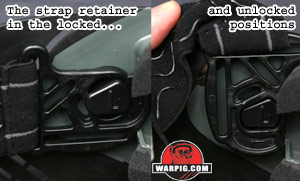 The
strap retainers simply rotate upward ¼ turn and unlock from the
lens retainers, and the strap can be removed. The natural pull of
the strap on the head when the goggle is worn helps ensure that the retainers
remain in the locked position securing both the strap and the lens during
use. In testing for review, several attempts were made to put the
Avatar on with the clips unlocked. Each attempt ended with the strap
either pulling free from the mask making it impossible to wear, or locking
itself into the lens retainer – either outcome preventing accidental use
of an unsecured strap or lens. The
strap retainers simply rotate upward ¼ turn and unlock from the
lens retainers, and the strap can be removed. The natural pull of
the strap on the head when the goggle is worn helps ensure that the retainers
remain in the locked position securing both the strap and the lens during
use. In testing for review, several attempts were made to put the
Avatar on with the clips unlocked. Each attempt ended with the strap
either pulling free from the mask making it impossible to wear, or locking
itself into the lens retainer – either outcome preventing accidental use
of an unsecured strap or lens.
 On
the field, the Vents Avatars proved to be comfortable to wear. They
provided a slim, low profile, close to the face feel. Despite extremely
humid conditions and on field exertion the single pane lenses did not exhibit
any signs of fogging. The image seen through the dark tinted stock
lens was crisp and sharp with high contrast. Optical distortion was
not at all noticeable when staring at a fixed object and twisting the head
from side to side (this is a simple way to check goggles for field distortion
that is not readily visible but can cause eye strain or headaches.)
The clear lens offered similar performance. On
the field, the Vents Avatars proved to be comfortable to wear. They
provided a slim, low profile, close to the face feel. Despite extremely
humid conditions and on field exertion the single pane lenses did not exhibit
any signs of fogging. The image seen through the dark tinted stock
lens was crisp and sharp with high contrast. Optical distortion was
not at all noticeable when staring at a fixed object and twisting the head
from side to side (this is a simple way to check goggles for field distortion
that is not readily visible but can cause eye strain or headaches.)
The clear lens offered similar performance.
An optional dual pane smoke tinted lens
was also used during review. While it offered a similarly clear and
bright image, slight field distortion was detected with the simple head
rotation test. This distortion was minor, and unnoticed in on field
use. It was considered comparable to that of other dual pane lenses
used in paintball.

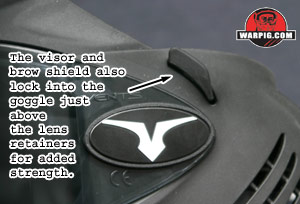 The
brow guard was easy to install, but a small downside of the packaging was
discovered in that the brow guard and or visor must be removed before the
goggle can be stored in its case. The microfiber cloth bags that
were included with the Avatar were handy not only for keeping the lenses
clean and the mask dust free when it was hanging from a d-ring walking
between fields at World Cup, but also for cleaning glasses and camera lenses.
For most goggle manufacturers the goggle bag, if included at all, is an
afterthought item, made from low grade or even scrap cloth. Having
the cloth of an appropriate grade to clean optics included was a nice plus. The
brow guard was easy to install, but a small downside of the packaging was
discovered in that the brow guard and or visor must be removed before the
goggle can be stored in its case. The microfiber cloth bags that
were included with the Avatar were handy not only for keeping the lenses
clean and the mask dust free when it was hanging from a d-ring walking
between fields at World Cup, but also for cleaning glasses and camera lenses.
For most goggle manufacturers the goggle bag, if included at all, is an
afterthought item, made from low grade or even scrap cloth. Having
the cloth of an appropriate grade to clean optics included was a nice plus.
Also tested during review were a pair
of Empire goggle straps. Functionally they worked the same as the
standard straps, with the exception of the silicone non-slip beading.
In addition to the three rows, it also features small silicone non-skid
Empire logos. The new straps performed the same as the original,
but offered a simple way for the goggles to be “customized” with a new
choice of color and strap design. The twist lock system meant that
they took only a moment to install.
Vents are back, and not just as one
goggle, but as a whole new line with interchangeable and upgradeable components
utilizing an innovative and fast lens retention system.
|




